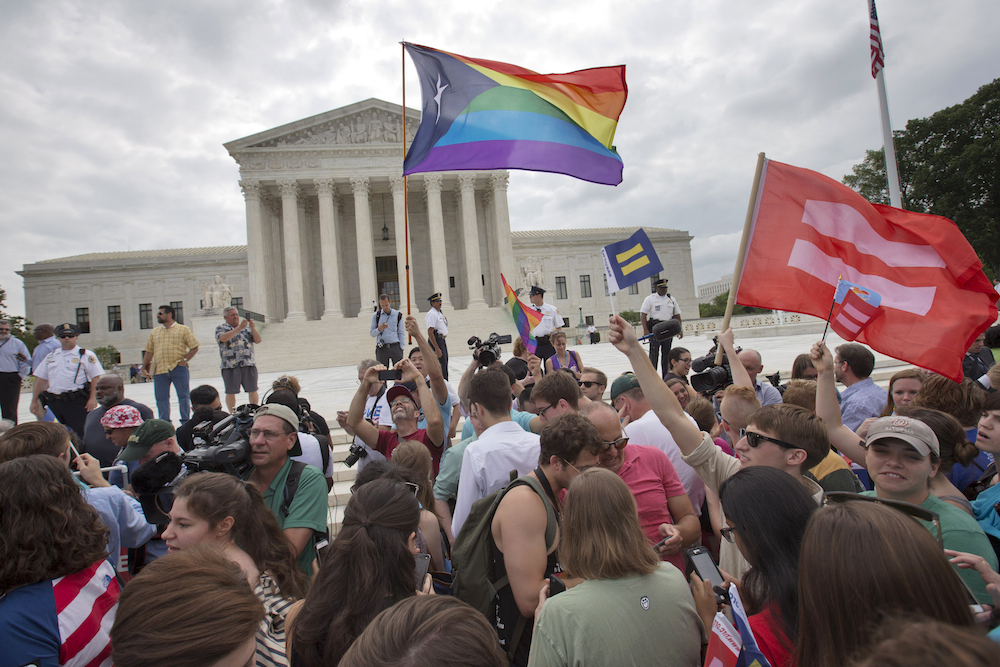
The crowd reacts as the ruling on same-sex marriage was announced outside of the Supreme Court in Washington, Friday June 26, 2015. The Supreme Court declared Friday that same-sex couples have a right to marry anywhere in the US. (AP Photo/Jacquelyn Martin)
On Friday, the Supreme Court ruled it’s unconstitutional to ban same-sex marriage. Here are some quick resources to help you cover the news now and plan how to cover what it will mean in your community.
— The Association of LGBT Journalists wrote an open letter about “Covering Marriage and the SCOTUS Decision.” Here are some guidelines NLGJA recommends:
First and foremost, report what the court actually decides. The language they choose, and the context in which it is released, will be the basis for any legal arguments going forward.
Proper framing of stories is essential when considering potential sourcing. Many opinions may be individually valid, but less appropriate when played against one another. Legal and theological expertise should be differentiated.
Journalists should consider diversity of opinion when bringing these stories to readers, viewers and listeners. Look beyond preconceived ideas regarding “pro” and “con” sides. Not all LGBT community members are in favor of marriage for same-sex couples; not all members of communities of faith are opposed.
Reporters should note the differences between marriage law and the legal designation of civil unions. Civil unions are presumed to extend many marriage benefits and protections; however, they do not include the federal protections and benefits available to married couples.
— The AP says “LGBT: Acceptable on first reference for lesbian, gay, bisexual and transgender. Should be spelled out in body of the story.” Also, “It’s same-sex marriage with a hyphen in same-sex.”
— Poynter’s News University has a free self-directed course called “Religion, Culture and Society: Getting Beyond the Cliches.” It includes this from the section on sexuality:
From California’s Proposition 8 to LGBT ordination to the U.S. military’s “don’t ask, don’t tell” policy, issues at the intersection of sexuality and public life are some of the hottest flash points in what we tend to reflexively call the culture wars.
That military metaphor, popular as it may be, often obscures the complexities of stories that, with just a little probing, can become richer and more dynamic. Here are examples of the kinds of questions we have in mind:
What’s really at stake for people who fiercely adhere to a particular reading of a sacred text?
Are compromises involved for those who enter politics to advocate for their religious views on issues like same-sex marriage?
Are conservative and progressive movements around issues of sexuality really as polarized and monolithic as they often appear in the news?
Is winning the right to marry, receiving ordination or serving in the military a priority for everyone in the LGBT community?
An old adage says there’s always more than one side to a story. In truth, there are always more than two sides. Reporting on politics, religion and sexuality is one of the best ways to test that premise.
— In June of this year, Pew Research Center published a study about “Changing Attitudes on Gay Marriage.”
In Pew Research polling in 2001, Americans opposed same-sex marriage by a 57% to 35% margin.
Since then, support for same-sex marriage has steadily grown. Today, a majority of Americans (57%) support same-sex marriage, compared with 39% who oppose it.
— Harvard’s Shorenstein Center on Media and Public Policy has a resource page for journalists with links to studies about same-sex marriage.
While offering resources, our archive also has stories marking major moments in the fight for same-sex marriage and how journalists cover it.
— In 2008, Poynter’s Kelly McBride asked journalists to think about how they’d play the kiss when same-sex couples get married.
— In 2011, Julie Moos shared front pages from New York after the same-sex marriage law was passed there.
— In 2012, McBride wrote about how journalists were expressing their views of the president’s support for gay marriage.
— Also in 2012, Andrew Beaujon wrote about Newsweek’s same-sex marriage cover.
One might, at this benighted point in print-journalism history, ask what difference the cover of a magazine actually makes. They’re not a huge economic force: Newsweek’s year-end publisher’s statement this past December gave an average of 40,342 single-copy sales per issue, down from 96,334 in 2007. But they still occupy a nice piece of cultural real estate. An article in a newsweekly has as much chance of becoming the focus of cultural conversation as a photo of a falling bear or a review of an Olive Garden in a North Dakota newspaper, but an arresting cover is an assertion that while print magazines’ power may have receded, they’re far from toothless.
— In 2013, Nisha Chittal wrote about arguments for and against journalists using same-sex symbols on social media.
Does changing your profile picture constitute taking a stance on a political issue — and does it compromise a journalist’s credibility? Will it antagonize readers or sources who engage with the journalist on social media platforms to see such a personal opinion displayed in such a prominent way on a journalist’s Facebook page?
The answer is a multi-layered one: it depends on the journalist, the outlet they work for, the social media platform, and whether the journalist is covering this week’s Supreme Court hearings.
— In June, Poynter’s Lauren Klinger shared tips on covering Pride month that may apply here, too.









